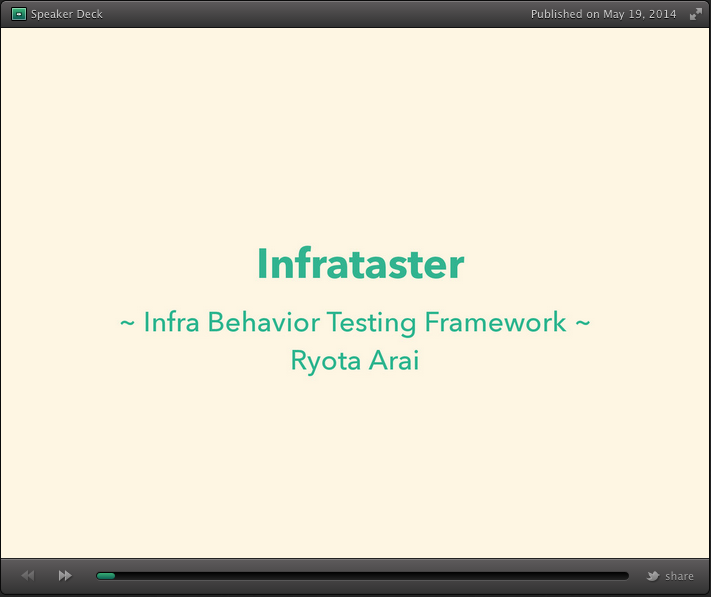Infrataster



Infrastructure Behavior Testing Framework.
Basic Usage with Vagrant
First, create Gemfile:
source 'https://rubygems.org'
gem 'infrataster'
Install gems:
$ bundle install
Install Vagrant: Official Docs
Create Vagrantfile:
Vagrant.configure("2") do |config|
config.vm.box = "hashicorp/precise64"
config.vm.define :proxy do |c|
c.vm.network "private_network", ip: "192.168.33.10"
c.vm.network "private_network", ip: "172.16.33.10", virtualbox__intnet: "infrataster-example"
end
config.vm.define :app do |c|
c.vm.network "private_network", ip: "172.16.33.11", virtualbox__intnet: "infrataster-example"
end
end
Start VMs:
$ vagrant up
Initialize rspec directory:
$ rspec --init
create spec/spec_helper.rb
create .rspec
require 'infrataster/rspec' and define target servers for testing in spec/spec_helper.rb:
require 'infrataster/rspec'
Infrataster::Server.define(
:proxy,
'192.168.0.0/16',
vagrant: true
)
Infrataster::Server.define(
:app,
'172.16.0.0/16',
vagrant: true,
from: :proxy
)
Or
require 'infrataster/rspec'
Infrataster::Server.define(:proxy) do |server|
server.address = '192.168.0.0/16'
server.vagrant = true
end
Infrataster::Server.define(:app) do |server|
server.address = '172.16.0.0/16'
server.vagrant = true
server.from = :proxy
end
Then, you can write spec files:
require 'spec_helper'
describe server(:app) do
describe http('http://app') do
it "responds content including 'Hello Sinatra'" do
expect(response.body).to include('Hello Sinatra')
end
it "responds as 'text/html'" do
expect(response.headers['content-type']).to eq("text/html")
end
end
end
Run tests:
$ bundle exec rspec
2 examples, 2 failures
Currently, the tests failed because the VM doesn't respond to HTTP request.
It's time to write provisioning instruction like Chef's cookbooks or Puppet's manifests!
Server
"Server" is a server you tests. This supports Vagrant, which is very useful to run servers for testing. Of course, you can test real servers.
You should define servers in spec_helper.rb like the following:
Infrataster::Server.define(
:proxy,
'192.168.0.0/16',
vagrant: true,
)
Infrataster::Server.define(
:app,
'172.16.0.0/16',
vagrant: true,
from: :proxy,
mysql: {user: 'app', password: 'app'},
)
You can specify SSH configuration manually too:
Infrataster::Server.define(
ssh: {host_name: 'hostname', user: 'testuser', keys: ['/path/to/id_rsa']}
)
fuzzy IP address
Infrataster has "fuzzy IP address" feature. You can pass IP address which has netmask (= CIDR) to Infrataster::Server#define. This needs vagrant option or ssh option which has host_name because this fetches all IP address via SSH and find the matching one.
Infrataster::Server.define(
:app,
'172.16.0.0/16',
)
Of course, you can set fully-specified IP address too.
Infrataster::Server.define(
:app,
'172.16.11.22',
'172.16.11.22/32',
)
#ssh_exec
You can execute a command on the server like the following:
describe server(:proxy) do
let(:time) { Time.now }
before do
current_server.ssh_exec "echo 'Hello' > /tmp/test-#{time.to_i}"
end
it "executes a command on the current server" do
result = current_server.ssh_exec("cat /tmp/test-#{time.to_i}")
expect(result.chomp).to eq('Hello')
end
end
This is useful to test cases which depends on the status of the server.
Resources
"Resource" is what you test by Infrataster. For instance, the following code describes http resource.
describe server(:app) do
describe http('http://example.com') do
it "responds content including 'Hello Sinatra'" do
expect(response.body).to include('Hello Sinatra')
end
end
end
http resource
http resource tests HTTP response when sending HTTP request.
It accepts method, params and header as options.
describe server(:app) do
describe http(
'http://app.example.com',
method: :post,
params: {'foo' => 'bar'},
headers: {'USER' => 'VALUE'}
) do
it "responds with content including 'app'" do
expect(response.body).to include('app')
end
end
describe http('http://app.example.com/gzipped') do
it "responds with content deflated by gzip" do
expect(response.headers['content-encoding']).to eq('gzip')
end
end
describe http('http://app.example.com/gzipped', inflate_gzip: true) do
it "responds with content inflated automatically" do
expect(response.headers['content-encoding']).to be_nil
expect(response.body).to eq('plain text')
end
end
describe http('http://app.example.com/redirect', follow_redirects: true) do
it "follows redirects" do
expect(response.status).to eq(200)
end
end
describe http('http://app.example.com', faraday_middleware: [
YourMiddleware,
[YourMiddleware, options]
]) do
it "uses the middlewares" do
expect(response.status).to eq(200)
end
end
end
capybara resource
capybara resource tests your web application by simulating real user's interaction.
describe server(:app) do
describe capybara('http://app.example.com') do
it 'shows food list' do
visit '/'
click_link 'Foods'
expect(page).to have_content 'Yummy Soup'
end
end
end
mysql_query resource
mysql_query resource is now in infrataster-plugin-mysql.
pgsql_query resource
pgsql_query resource sends a query to PostgreSQL server.
pgsql_query is provided by infrataster-plugin-pgsql by @SnehaM.
dns resource
dns resource sends a query to DNS server.
dns is provided by infrataster-plugin-dns by @otahi.
memcached resource
memcached resource sends a query to memcached server.
memcached is provided by infrataster-plugin-memecached by @rahulkhengare.
redis resource
redis resource sends a query to redis server.
redis is provided by infrataster-plugin-redis by @rahulkhengare.
firewall resource
firewall resource tests your firewalls.
firewall is provided by infrataster-plugin-firewall by @otahi.
Example
Tests
Unit Tests
Unit tests are under spec/unit directory.
$ bundle exec rake spec:unit
Integration Tests
Integration tests are under spec/integration directory.
$ bundle exec rake spec:integration:prepare
$ bundle exec rake spec:integration
Presentations and Articles

Changelog
Changelog
Contributing
- Fork it ( http://github.com/ryotarai/infrataster/fork )
- Create your feature branch (
git checkout -b my-new-feature) - Commit your changes (
git commit -am 'Add some feature') - Push to the branch (
git push origin my-new-feature) - Create new Pull Request






